�
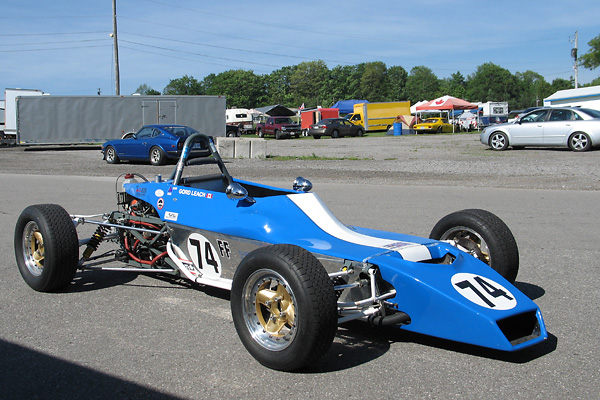
�
Gord Leach's 1974 Hawke DL11 Formula Ford Racecar
� � Owner: Gord Leach� City: Regina, Saskatchewan
� Model: 1974 Hawke DL11
� Engine: 1.6L Ford four-cylinder
� Race prepared by: owner�
�
David Lazenby and his Hawke Racing Cars
��
David Lazenby joined Lotus in 1961, and in 1963 he was assigned to be Jim Clark's race mechanic.�
In this capacity he prepared and maintained Clark's Formula One and Indianapolis 500 cars.�
Lazenby was a central figure in the small team that helped Clark win the 1965 Indy 500. His�
career at Lotus looked bright. In 1968, Lazenby was named General Manager of Lotus Components Ltd.,�
the division of Lotus which built racecars for outside customers. These were the early days of�
the exciting new Formula Ford amateur racing class, and customer demand for Lotus 51 Formula Fords�
was booming.�
�
Apparently the promotion didn't suit Lazenby well enough, because at the end of the 1968�
he resigned from Lotus and started his own racecar business. David Lazenby & Co. Ltd.�
only sold a modest number of Formula Fords and never advanced into building cars for�
professional racing classes, but ultimately Lazenby's company produced some very successful�
Formula Ford racecars. David Lazenby was the principle designer of all their models.�
�
From early 1969, Lazenby worked out of a small workshop in the cozy parish village of Nazeing�
(near Waltham Abbey). Lazenby shared the shop with an old hawk, and soon appropriated and modified�
the word "hawk" as a trade name for his products. The very first Hawke racecar was built to order�
for the man who owned the workshop building. Retrospectively identified as a DL1, this car is�
remembered as the prototype for the DL2, DL2A and DL2B models which followed.�
The DL1 featured an unusually long nose cone which proved vulnerable in traffic, and also an�
uncommonly well-braced frame because driver protection was a design priority from the company's�
beginning. From the early days of his new enterprise, Lazenby kept bills paid by producing�
close-ratio gears for the Renault gearboxes used in early Lotus Formula Fords. (Hewland gears�
and steering racks became staple products later.) After a short while, Lazenby relocated to a�
larger premises on the Waltham Cross high street.�
�
Canada and the United States proved especially receptive markets for Hawke cars and sales grew.�
According to a contemporary Motor Sport magazine article ("They Make Racing Cars", December 1971)�
28 Hawke DL2 Formula Fords were built in 1969 followed by 54 Hawke DL2A cars in 1970. (The Hawke�
Registry reports a much lower number.) A Hawke DL2A won the 1970 Canadian "Bulova Cup"�
Formula Ford Championship. Aside from a handful of examples that prove the rule, DL2 and DL2A�
frames were fabricated to order from Racing Frames and from Arch Motors respectively.�
�
�
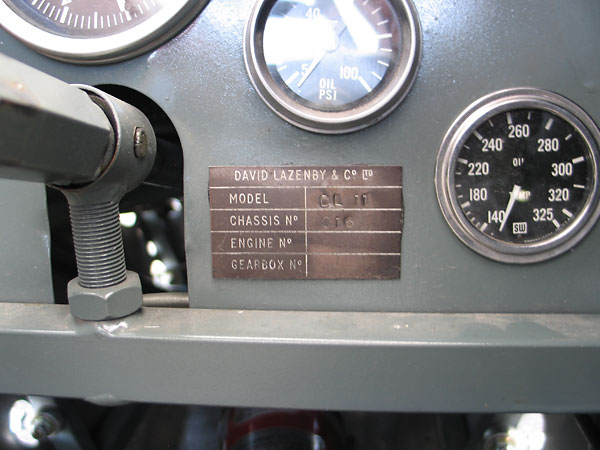
�
David Lazenby & Co. Ltd.
�
Model DL11, Chassis No. 016, Engine No. (blank), Gearbox No. (blank)
�
(Note also the custom fabricated adjustable steering column support.)
�
�
For 1971, production was split between the latest revision of the Formula Ford model (DL2B)�
and a new Super Vee model (DL5). By late 1971, Hawke frame production moved in-house. Interestingly,�
Hawkes always used fabricated steel uprights (a.k.a. hub carriers) rather than any sort of cast or�
forged uprights. They reasoned and advertised that these were safer because they would likely�
deform but not fracture in most severe accidents. Hawke kept most of their small fabricated parts�
in-house. Several different suppliers were tried for fiberglass body panels. At least through the�
early years, SAH Accessories in Leighton Buzzard was their preferred fiberglass supplier.�
�
For 1972, production was split between two new models the Hawke DL8 for Super Vee and the Hawke DL9 for�
Formula Ford. According to the company's sales literature, the two models had exactly the same�
nominal wheelbase (88.5"), track (54.0" front and rear), and weight (882 pounds). What's really�
interesting about these two models is the design of their space frames; instead of round tubes, these�
new models and their successors were mainly constructed from box tubing and special "formed beams�
in the cockpit to provide great strength and maximum driver protection." Whereas earlier Hawke�
Formula Fords had nose pod mounted radiators, the DL9 had two side mounted Serck radiators supplemented�
by a nose mounted oil cooler. About 30 Hawke DL9 race cars were produced.�
�
For 1973, Super Vee had largely fizzled out and the company's production focused on a new�
Formula Ford model, the Hawke DL10. Both the space frame and the body were substantially different�
from the previous (DL9) model, but performance was disappointing. About 25 Hawke DL10 race cars were�
produced, but many of them were upgraded to DL11 specifications. (Changes included updated rear�
suspension pick-up points and geometry.)�
�
�
Enjoying this article? www.BritishRaceCar.com is partially funded through generous support from readers like you!
�
To contribute to our operating budget, please click here and follow the instructions.
�
(Suggested contribution is twenty bucks per year. Feel free to give more!)�
�
With the Hawke DL11 David Lazenby finally had a top performing Formula Ford design. The difference�
came through extensive testing. An enthusiastic employee named John Bicht got on track and drove the�
DL11 test mule at every reasonable opportunity over the course of its seven month development. Another�
driver's name is also closely associated with the DL11: Syd Fox drove a DL11 to victory in the�
1973 Sunbeam Electric Championship, and also to an impressive third place finish in the 1973 Formula�
Ford Festival. (Formula Ford was a popular enough class in England through this era that three competing�
championship series were held. The Formula Ford Festival ended up more prestigious than any of these�
because it brought together top drivers from all over England and also from much of Europe.)�
�
Although Formula Ford was still popular, sales were down for most race car constructors through�
1973 and 1974. Following the Arab oil embargo, gasoline was a precious commodity and there were�
persistent pernicious rumors that racing might be banned. Only about 30 Hawke DL11 race cars were�
built, although production spanned from 1973 through 1974. Late in 1974, Lazenby produced a very�
small number of specially streamlined "Super Slipstreamer" (a.k.a. DL12) Formula Fords. Roy Klomfass�
drove a Super Slipstreamer to Sunbeam Electric Championship victory in 1974. �
�
Even greater success awaited future Hawke models. Lazenby's cars dominated the 1976 Formula Ford�
Festival with Derek Daly, Derek Warwick, and Rick Morris in a 1-2-3 finish (driving two DL17s and�
one DL15, respectively.) A young driver named Nigel Mansell also drove a Hawke DL17 throughout his�
1976 season.�
�
Besides Gord Leach's car, the Hawke Registry lists ten remaining Hawke DL11 racecars (worldwide),�
plus three DL12s. No Hawke DL10 racecars are known to have survived.�
�
�
 �
�
�
�
Discovered: Factory-Recommended Hawke DL11 Set-Up Measurements
�| Front | Rear | ||
| Ride height | 2.75"-3" | 3.5"-3.75" | |
| Camber | 0.5 degree | 1 degree | |
| Castor | 0.75 degree | 0 degree | |
| Toe-in | 1/16" each wheel | 1/16" each wheel | |
| Dampers | 1 turn | 1.75 turn | |
| Tire pressure | 14-16 psi | 16-18 psi |
Features and Specifications
�| Engine: | �1.6L Ford four-cylinder, built by Brian Stewart Racing Inc., Toronto Canada.�
Weber 32/36 DGV carburetor.�
Shankle tuned length velocity stacks (used without filters).�
Motorcraft distributor.�
Belden Premium 7mm spark plug wires.�
Rowland Ford oil pump.�
Mocal remote oil filter mount.�
Fram PH2950 oil filter.�
Mocal 10-row oil cooler. | �
| Cooling: | �original copper/brass crossflow radiator. | �
| Exhaust: | �four-into-one header. | �
| Transmission: | �Hewland Mark 8 4-speed. | �
| Front Susp.: | �unequal length wide-based wishbones.�
Hawke proprietary fabricated steel uprights.�
Spax steel bodied adjustable coilover shock absorbers.�
Adjustable tubular 5/8" anti-sway bar. | �
| Rear Susp.: | �dual lower links, single top links, and twin adjustable trailing links.�
Hawke proprietary fabricated steel uprights.�
Spax steel bodied adjustable coilover shock absorbers.�
Adjustable tubular 1/2" anti-sway bar. | �
| Brakes: | �(master) dual Girling master cylinders with integral reservoirs, and with bias bar. � (front) Lockheed LD20 calipers. Cross-drilled rotors. � (rear) Lockheed LD20 calipers. Cross-drilled rotors. | �
| Wheels/Tires: | �Revolution modular (3-piece) aluminum wheels.�
Dunlop Racing "Formula Ford" tires (135/545-13 CR82 front, 165/580-13 CR82 rear). | �
| Electrical: | �Lucas master battery cutoff switch.�
PowerSonic PS12180 sealed absorbent glass mat lead/acid battery. | �
| Instruments: | �(left to right) Stewart Warner water temperature gauge (100-230F),�
Jones mechanical tachometer (0-10000rpm),�
Stewart Warner oil pressure gauge (5-100psi). �
Stewart Warner oil temperature gauge (140-325F).�
| �
| Fuel System: | �ATL FC152 5-gallon fuel cell.�
FF1600 mechanical fuel pump with push-on fittings. | �
| Safety Eqmt: | �Racers Choice six-point cam-lock safety harness.�
Phoenix centralized fire suppression system.�
Quick release steering wheel hub, on a Moto-Lita steering wheel. | �
| Racing Class: | �Formula Ford. | �
Engine Installation
��
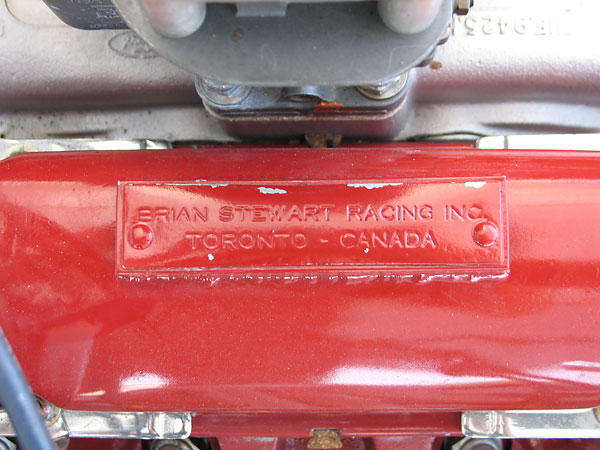
�
Brian Stewart Racing Inc. of Toronto once built this engine. Mechanic, turned Formula Ford championship winning
�
driver, turned professional racing team owner... Brian Stewart is among the best known and most respected figures
�
in Canadian racing. His team won the Indy Lights championship in 2005. BSR is also a full service race shop.
�
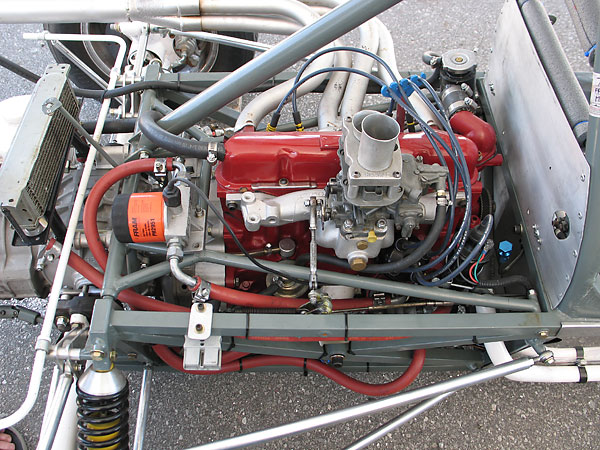
�
Weber 32/36 DGV carburetor on an original Ford intake manifold, as mandated by class rules.
�
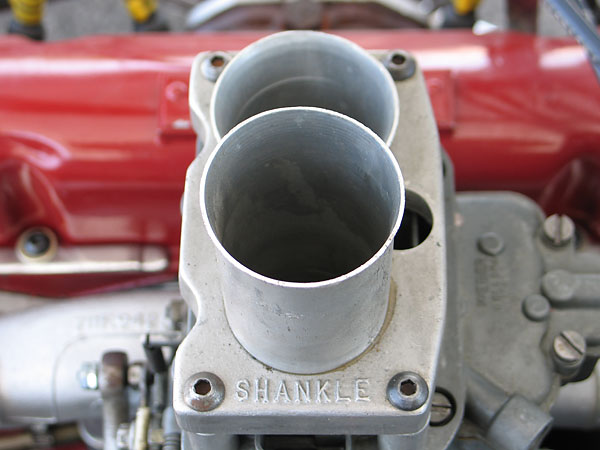
�
Shankle velocity stacks are designed to make altering induction tract length easy. The effect is somewhat like
�
optimizing exhaust lengths. Trimming the trumpets generally shifts peak torque to a higher engine speed.
�
Fitting longer trumpets has the opposite effect. In either case, the bell of the trumpet helps smooth airflow
�
into the induction tract. (The bigger the bell radius, the better.) Here, one stack is shorter than the other.
�
This may have been done to correct mismatched intake manifold runner lengths.
�
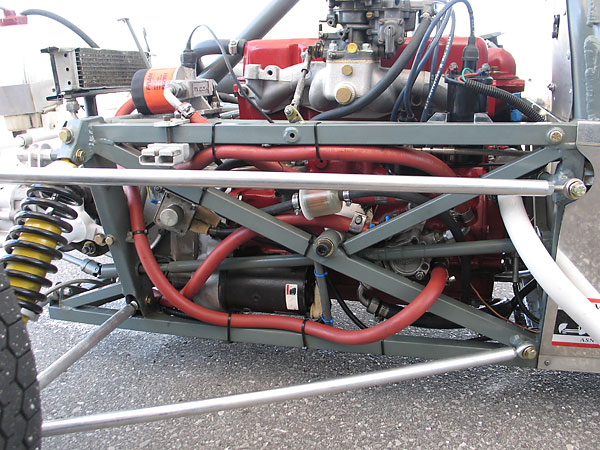
�
Full size starter motor.
�
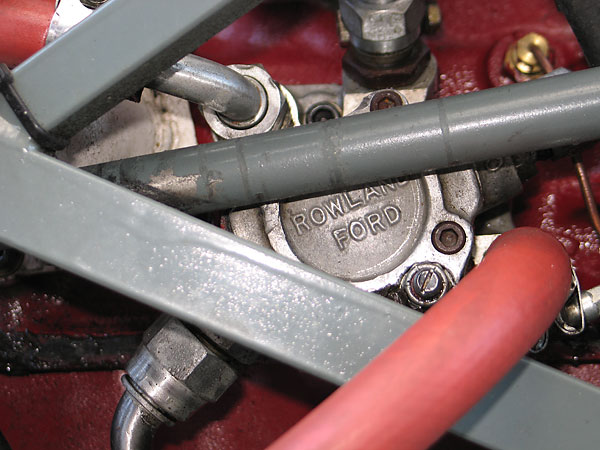
�
Rowland Ford oil pump.
�
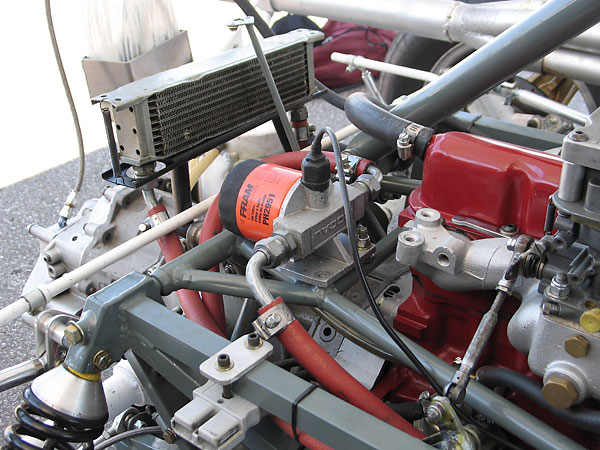
�
Mocal remote oil filter mount and Fram PH2950 oil filter. Mocal 10-row oil cooler.
�
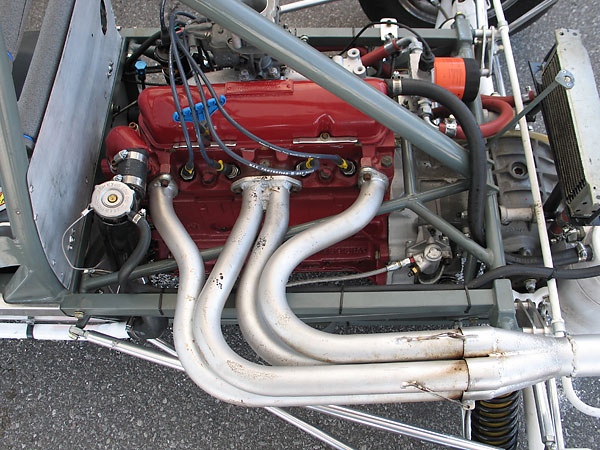
�
4-into-1 exhaust header. Girling clutch slave cylinder.
�
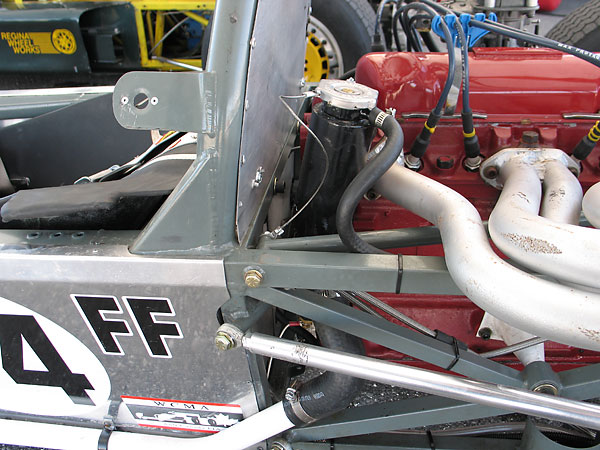
�
The filler cap is up high to ensure that coolant fills the cylinder head's water jacket.
�
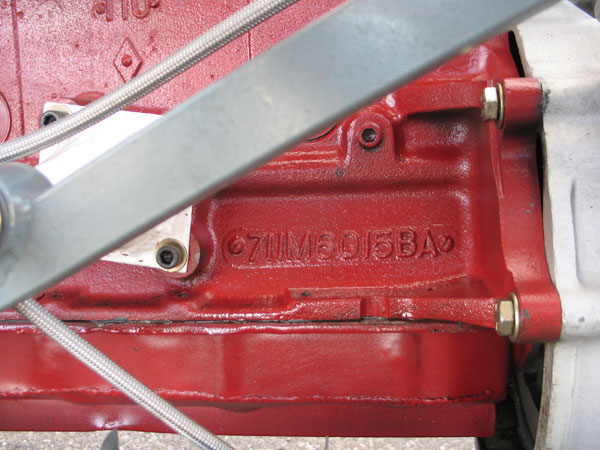
�
Casting number 711M6015BA indicates that this block is a 1600cc "tall" block with big bearing caps.
�
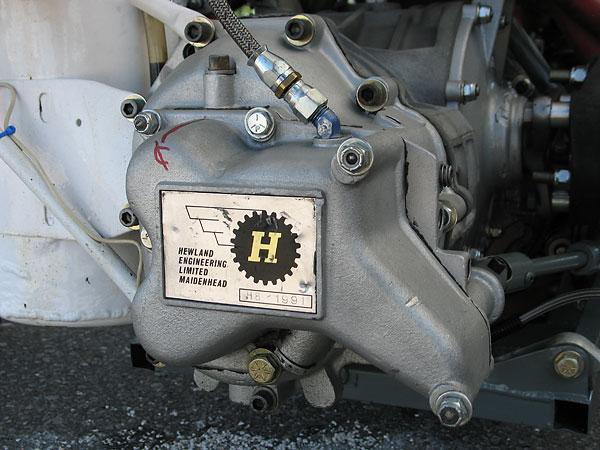
�
Hewland transaxle: H8-1991
�
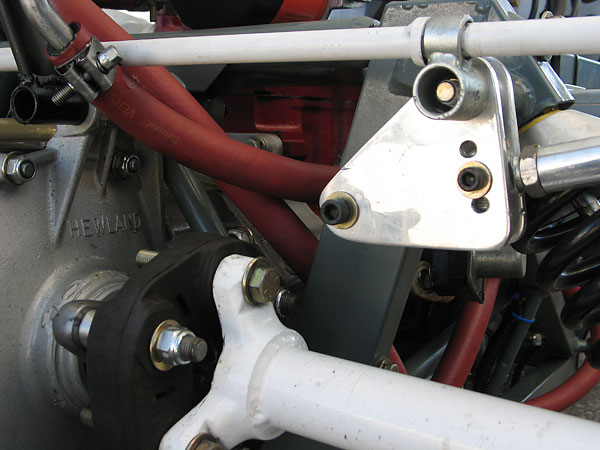
�
Metalastic drive donuts are a characteristic component of vintage Formula Fords.
�
Front Suspension, etc.
��
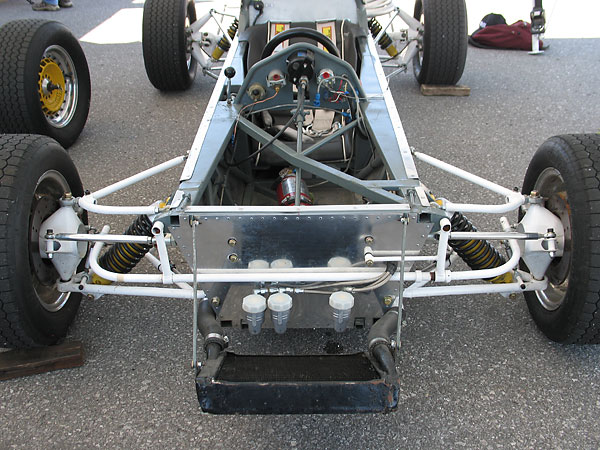
�
One unusual feature of all Hawke suspensions is their fabricated steel front and rear uprights (a.k.a. hub
�
carriers). Their competitors mainly used Alford and Alder forged front uprights (from Triumph street cars)
�
or custom magnesium castings. Hawke promoted their steel uprights as a safety over magnesium or
�
aluminum castings because they're more likely to bend rather than break in an accident.
�
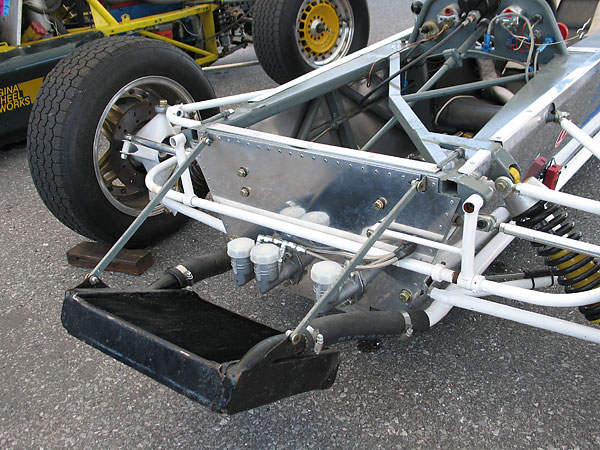
�
Whereas many early Formula Ford constructors routed coolant to front-mounted radiators through
�
frame tubes, Hawke preferred to mount coolant lines outboard of the frame. Note also that this
�
original copper-and-brass radiator is flexibly supported by just two stay rods and two hoses.
�
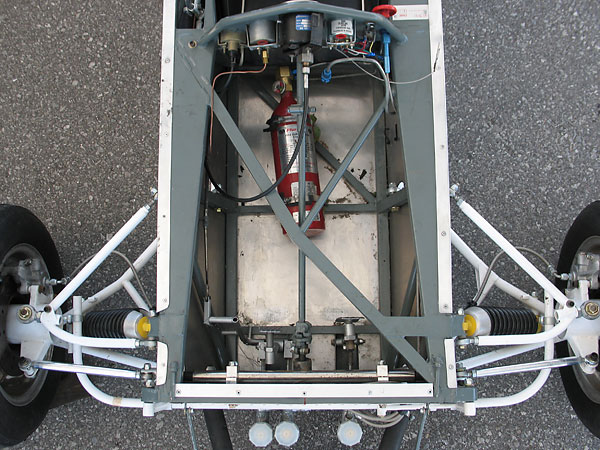
�
This frame is primarily composed of square "box" tubing, where other early Formula Ford designs
�
mainly used round tubing. Among the advantages of box tubing: frame joints are easier to fabricate
�
since no "fishmouth" cuts are required and the flat surfaces of the tubes make it easier to install
�
bulkheads or to mount accessories. Generally, round-tube frames can be made lighter weight.
�
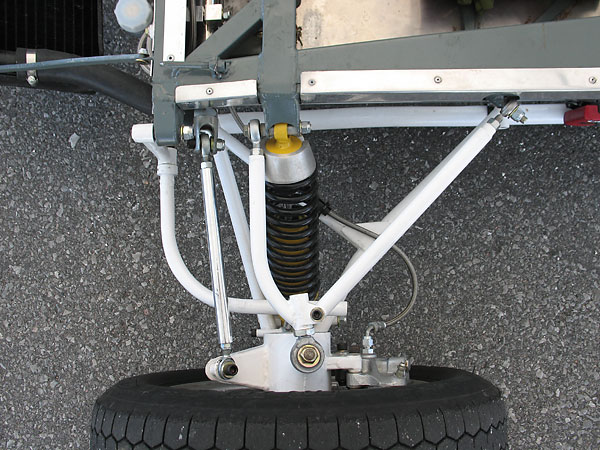
�
Mounted atop the corner of the frame, you can see one of the pins that locate the bodywork.
�
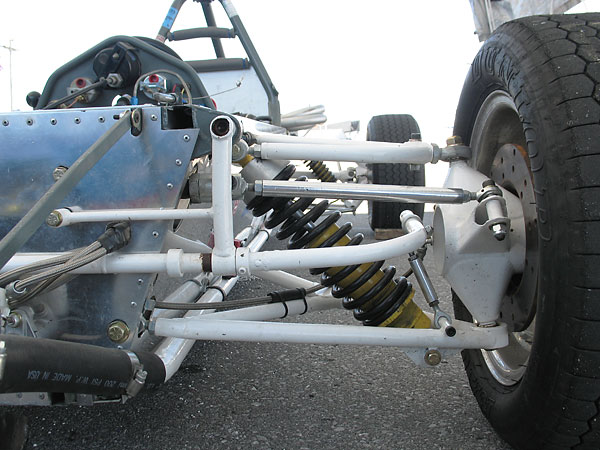
�
Old Hawke sales literature indicates that either Armstrong or Spax shock absorbers were provided.
�
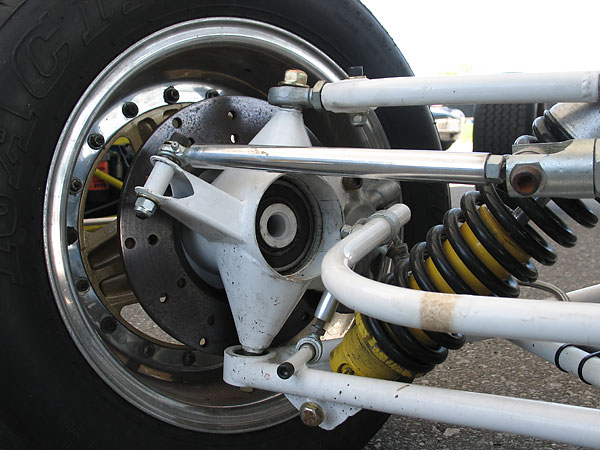
�
Evidentally to correct a bump steer issue, steering links have been reconnected to the uprights above
�
their normal connection point. (In the "before picture", steering links were connected this way too.)
�
In this view, you can also see the shock absorber adjustment valve.
�
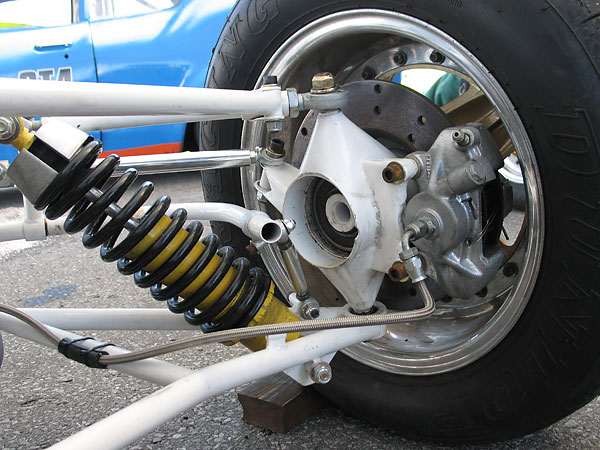
�
Vintage Formula Ford racecars use steel-bodied shock absorbers. (Club rules prohibit aluminum shocks.)
�
In this view you can also see that the car has Lockheed LD20 calipers, which would have been a very
�
modern spec for 1973. Up until that time, Girling calipers were ubiquitous in Formula Ford.
�
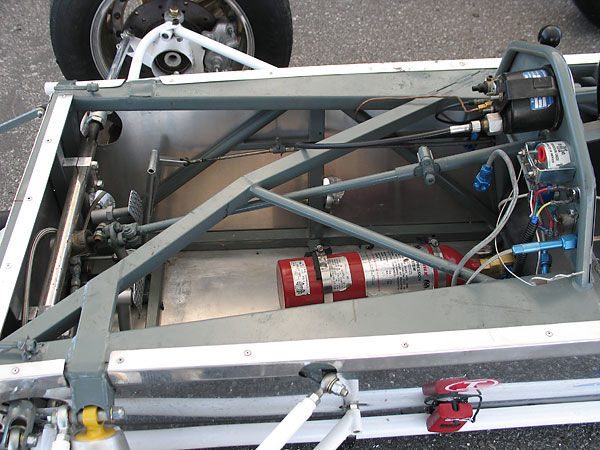
�
Note the clamp on the steering column which facilitates moving the steering wheel rearward.
�
This view also shows the wide spacing of rivets on the car's aluminum side panels. Class rules
�
explicitly prohibited closer rivet spacing to keep side panels from functioning as "stressed skins".
�
(It was a stupid rule for many reasons. For example, adhesives were already available which were
�
stronger than rivets and completely undetectable without dissassembly. Besides, why shouldn't a
�
race car chassis be as strong and as safe as possible, especially when the difference is so cheap?)
�
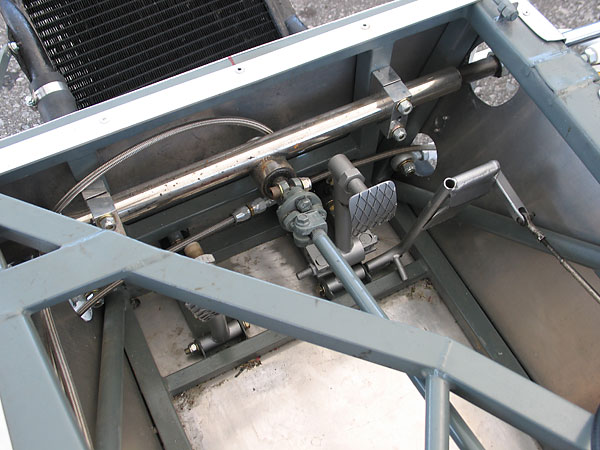
�
Unlike many other early Formula Fords, on the Hawke DL11 the steering rack is mounted rearward of the
�
frame's front bulkhead. Hawke constucted their own steering racks, and in fact offered custom made
�
steering racks for all sorts of applications. Note also the flexible steering shaft coupling (a.k.a. rag joint).
�
�
Rear Suspension
��
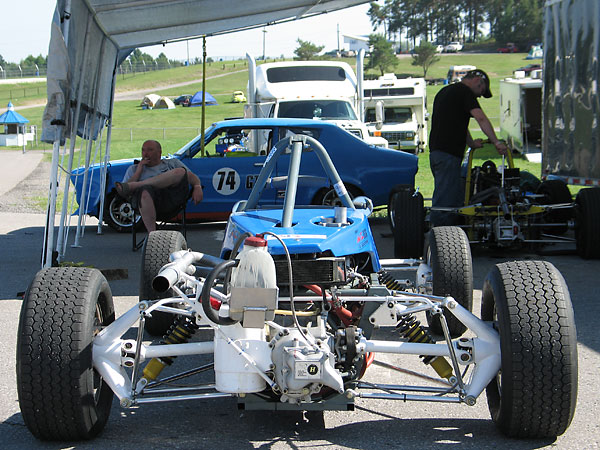
�
Dual lower links, single top links, and twin adjustable trailing links.
�
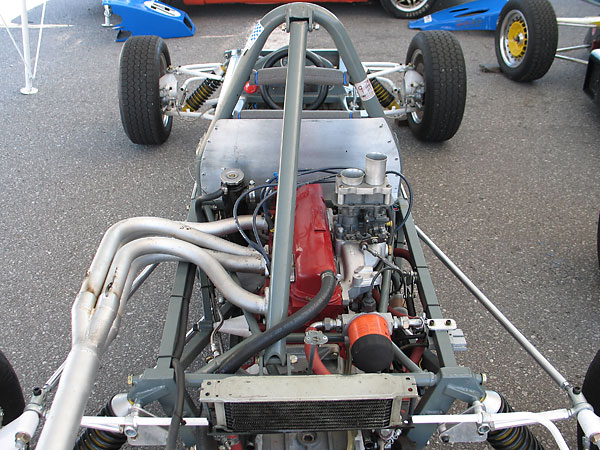
�
A robust roll hoop brace.
�
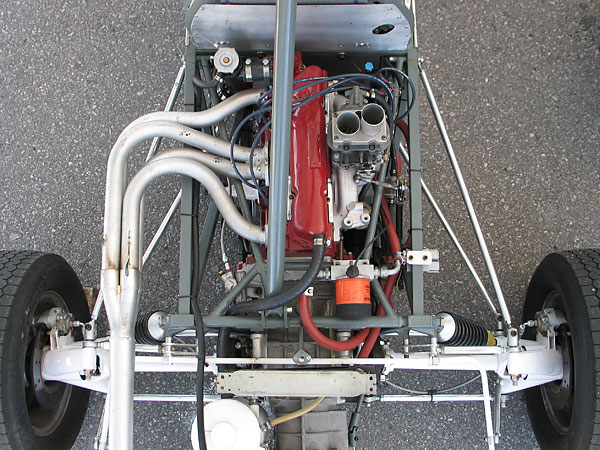
�
When Gord purchased his DL11, it had a canister muffler clamped just behind the exhaust collector.
�
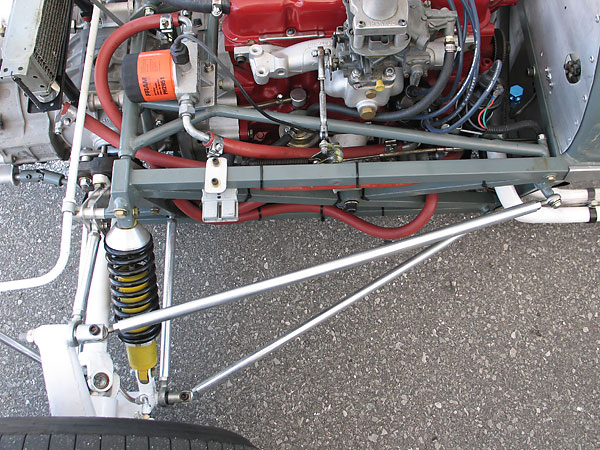
�
One way to make radius rods is to drill and tap holes into the ends of solid extruded aluminum bars.
�
The original radius rods were made from steel tube with welded-on threaded plugs at each end.
�
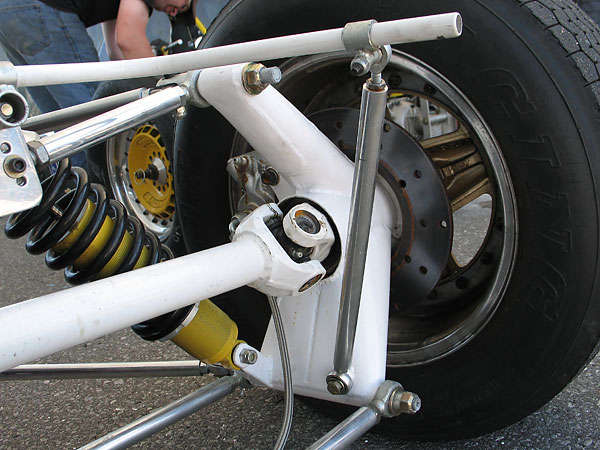
�
The core of a solid anti-sway bar adds very little to its torsional stiffness, so it makes
�
excellent sense to use tubing instead - as shown on both the front and rear of this racecar.
�
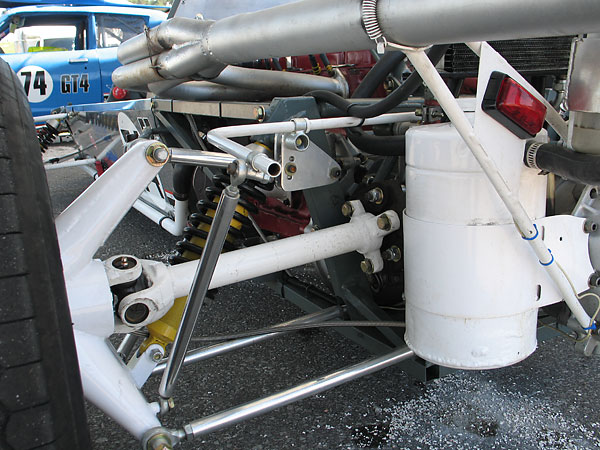
�
Although painted now, the engine oil reservoir is an aluminum fabrication.
�
�
Interior
��
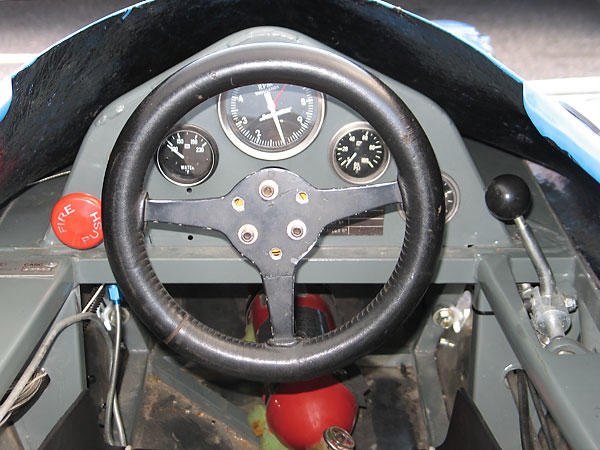
�
Moto-Lita steering wheel.
�
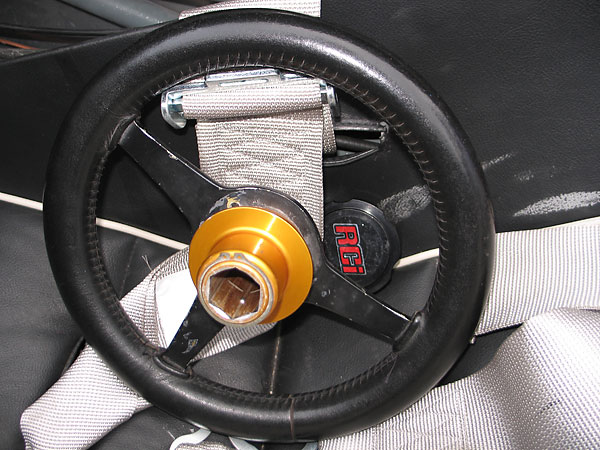
�
Quick release steering wheel hub.
�
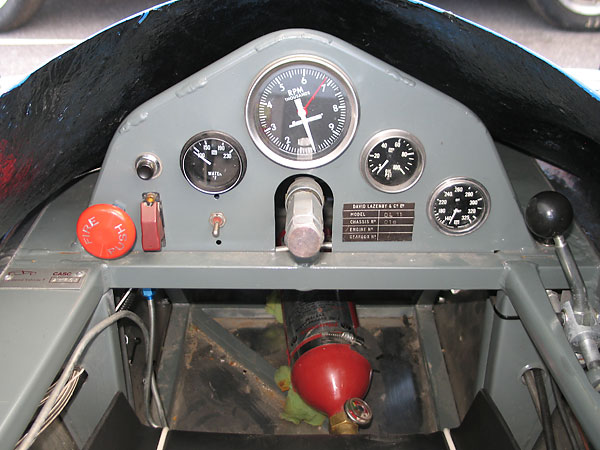
�
Stewart Warner water temperature gauge (100-230F), Jones mechanical tachometer (0-10000rpm),
�
Stewart Warner oil pressure gauge (5-100psi) and oil temperature gauge (140-325F).
�
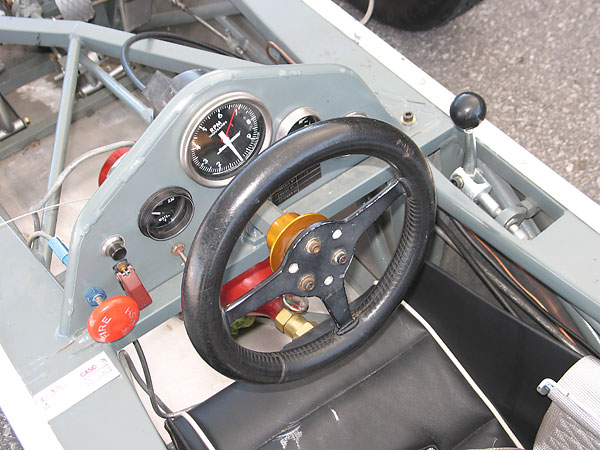
�
Fabricated steel instrument panel.
�
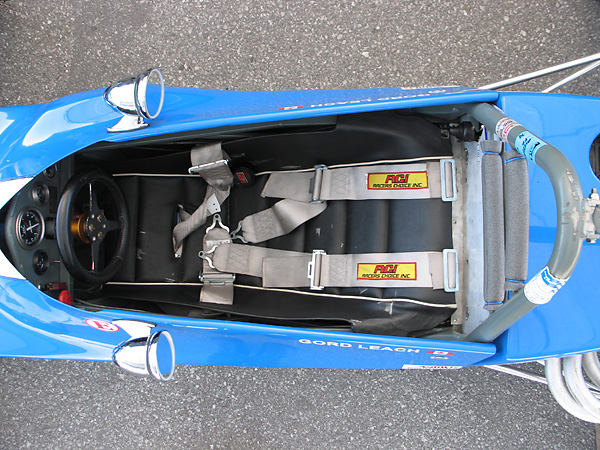
�
Racers Choice six-point cam-lock safety harness.
�
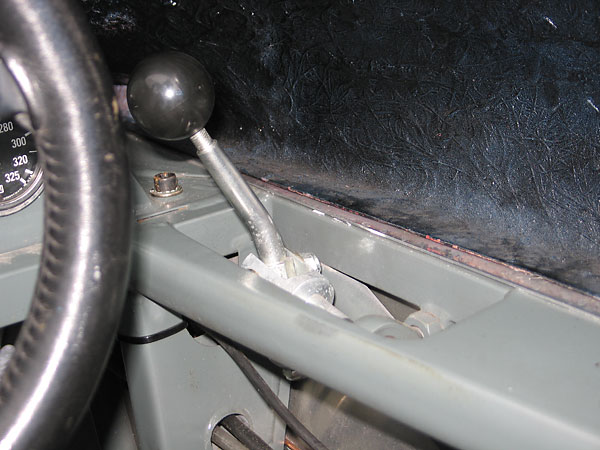
�
Gear selector.
�
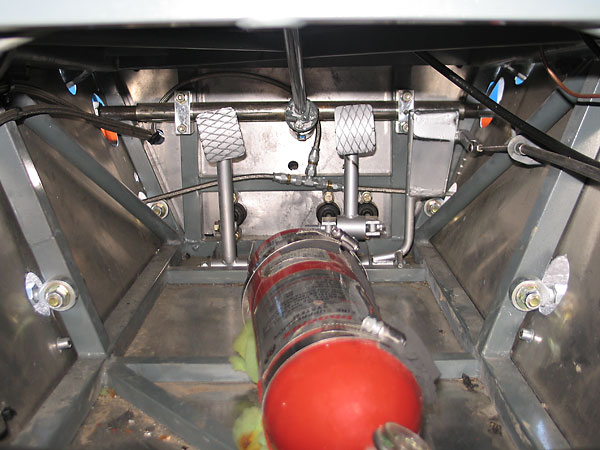
�
Phoenix centralized fire suppression system.
�
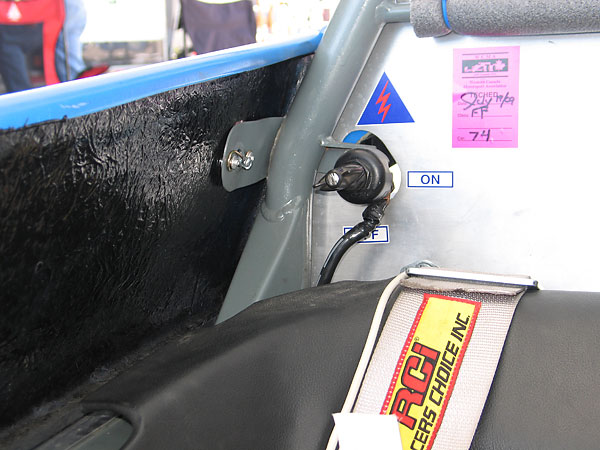
�
Lucas master battery cutoff switch.
�
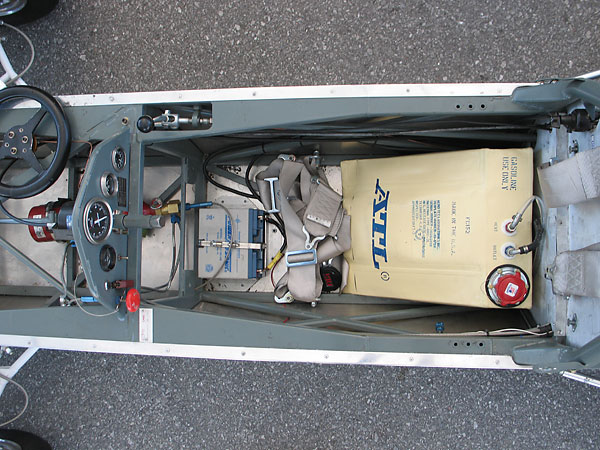
�
PowerSonic PS12180 sealed absorbent glass mat lead/acid battery.
�
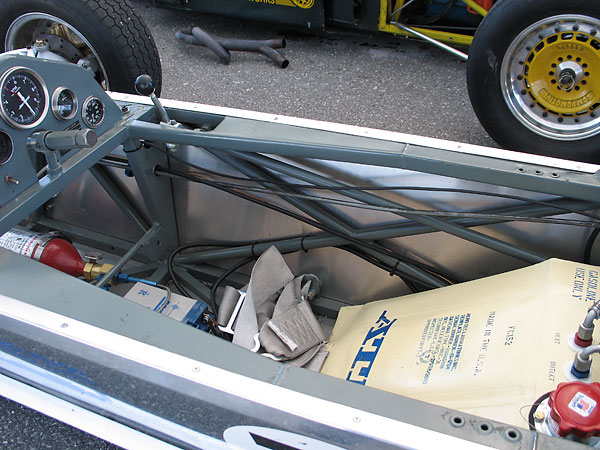
�
ATL FC152 5-gallon fuel cell.
�
�
Exterior
��
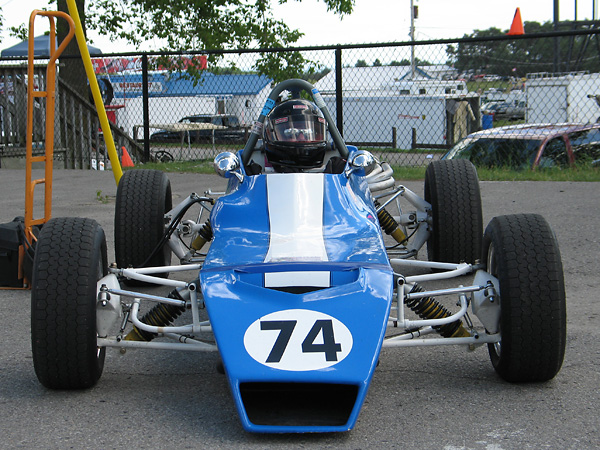
�
During VARAC's 31st Intl. Vintage Racing Festival at Mosport, Gord Leach piloted his vintage Hawke DL11
�
Formula Ford around the challenging 3.957Km racetrack with lap speeds of about 1 minute, 49 seconds.
�
That works out to an average speed of over 130.2kph (~80.9mph).
�
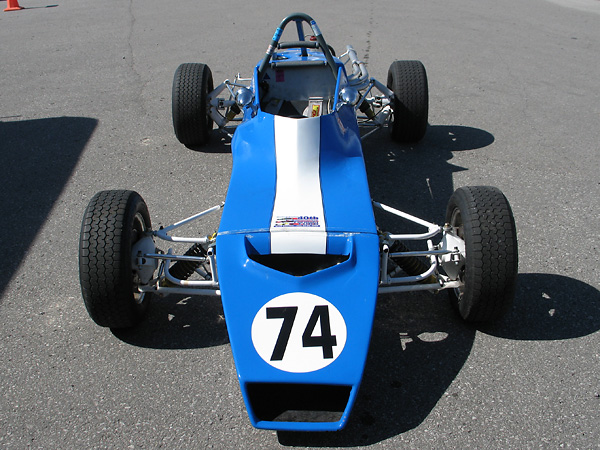
�
decal: United States 40th Anniversary of Formula Ford, Road America, July 24-26, 2009.
�
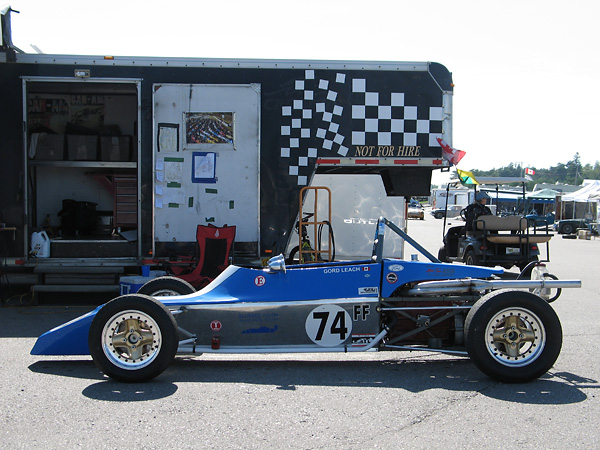
�
It sits high empty, but it will settle with nicely with the driver installed.
�
Factory reccommended ride height: 2.75"-3" (front) and 3.5"-3.75" (rear).
�
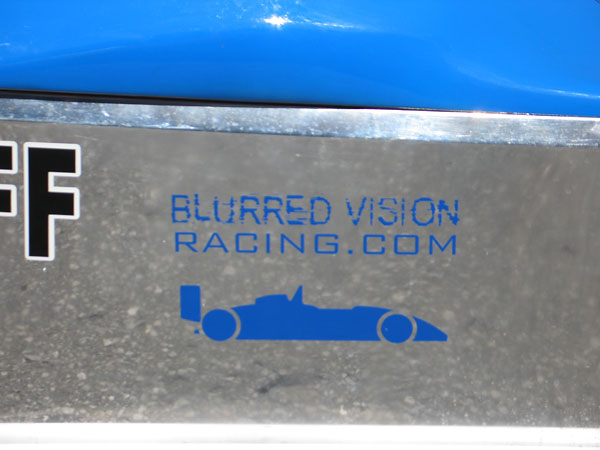
�
decal: BlurredVisionRacing.com
�
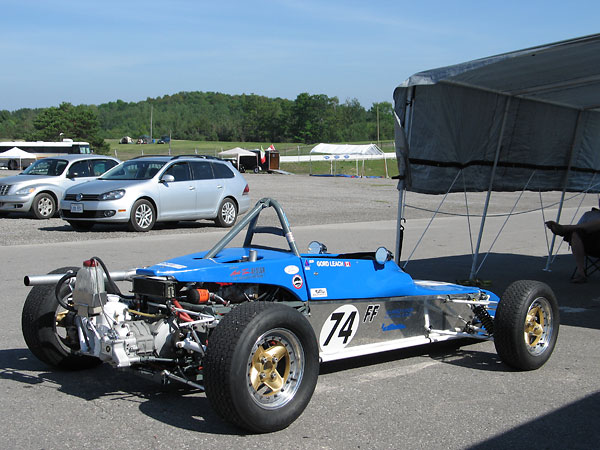
�
After a couple years of experience with side-pod mounted radiators, Lazenby returned to a single
�
nose-pod mounted radiator for the Hawke DL11. Coolant was routed in external lines by necessity.
�
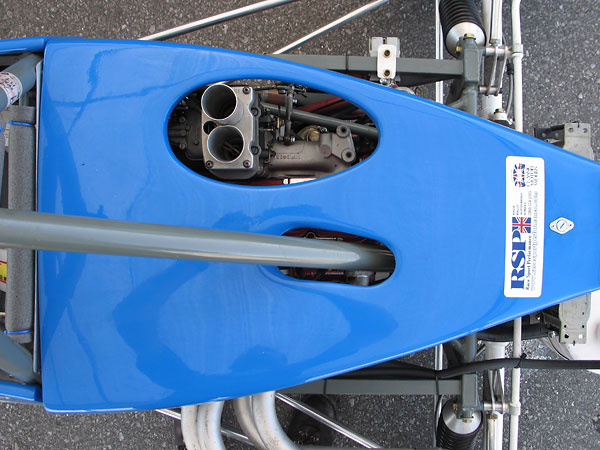
�
decal: Race Sport Performance of St. Andrews, Manitoba
�
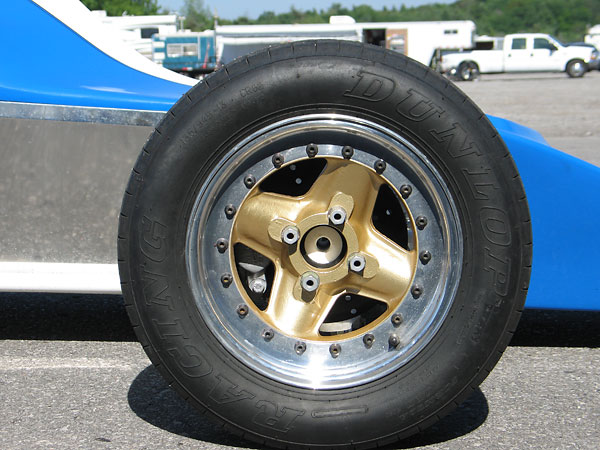
�
Revolution modular (3-piece) aluminum wheels.
�
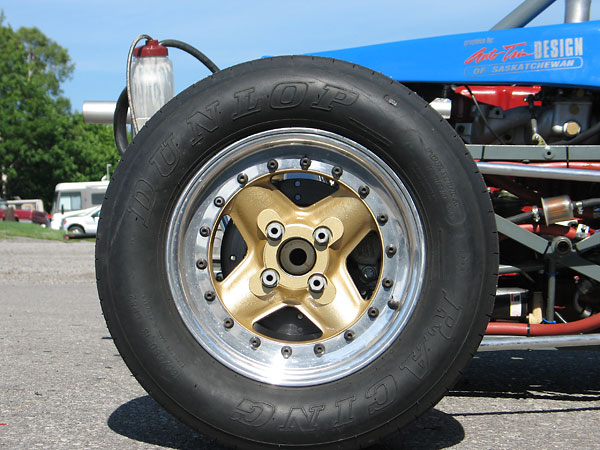
�
Dunlop Racing "Formula Ford" tires (135/545-13 CR82 front, 165/580-13 CR82 rear).
�
�
All photos shown here are from June 2010 when we viewed the car at VARAC's 31st Intl. Vintage Racing Festival�
at Mosport Motorsports Park, in Ontario Canada. Photos by Curtis Jacobson for BritishRaceCar.com, �
copyright 2010. All rights reserved.
�
| If you liked this article, you'll probably also enjoy these: | �|||||
 | �
Dick Leehr 1968 Lotus 51c | �
 | �
Scott Fairchild 1972 Royale RP3A | �
 | �
Michael Snowdon 1972 GRD 272 | �
| You're invited to discuss anything you've seen here on The British Racecar Motorsports Forum! | �|||||
�
Notice: all the articles and almost all the photos on BritishRacecar.com are by Curtis Jacobson.
�
(Photos that aren't by Curtis are explicitly credited.) Reproduction without prior written permission is prohibited.
�
Contact us to purchase images or reproduction permission. Higher resolution images are optionally available.
�

 �
�